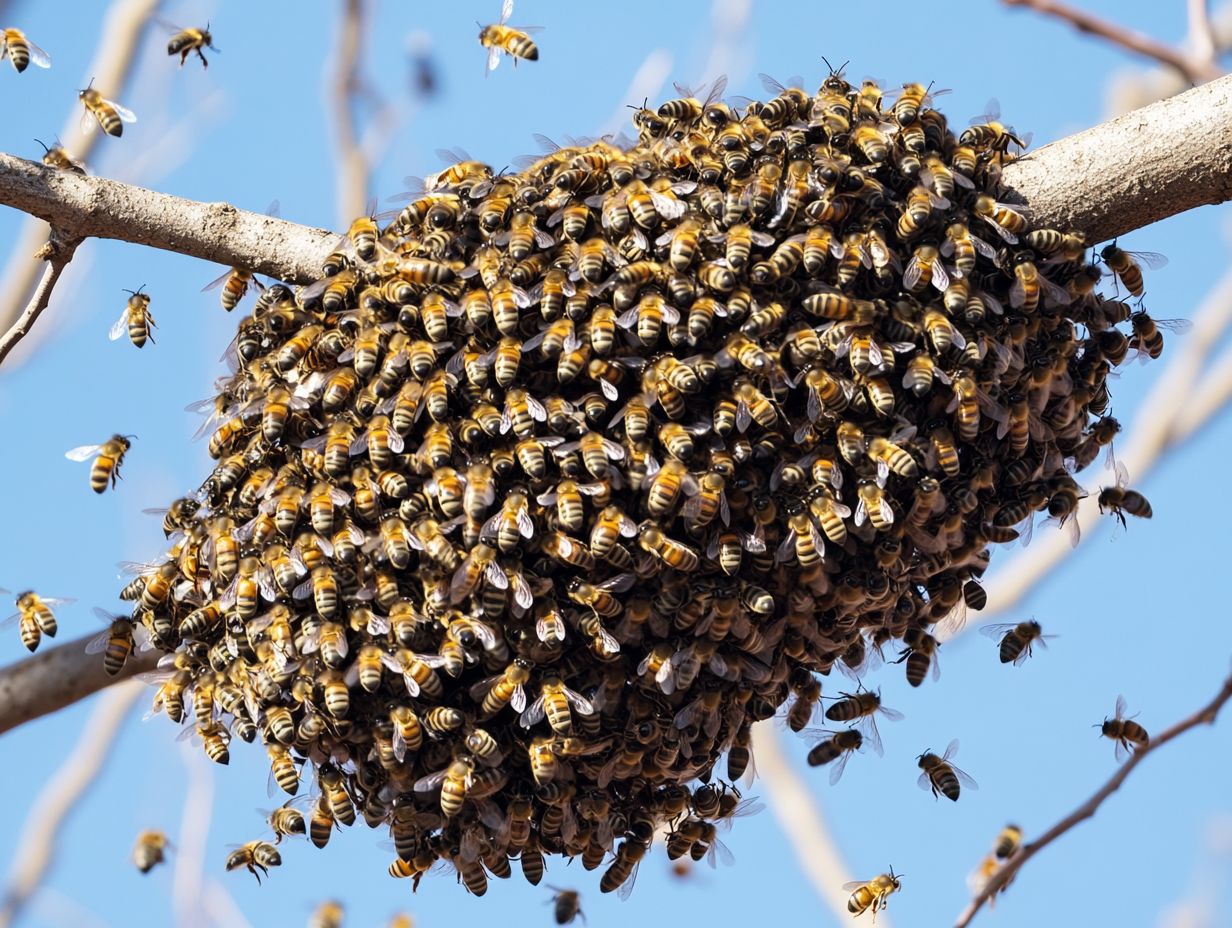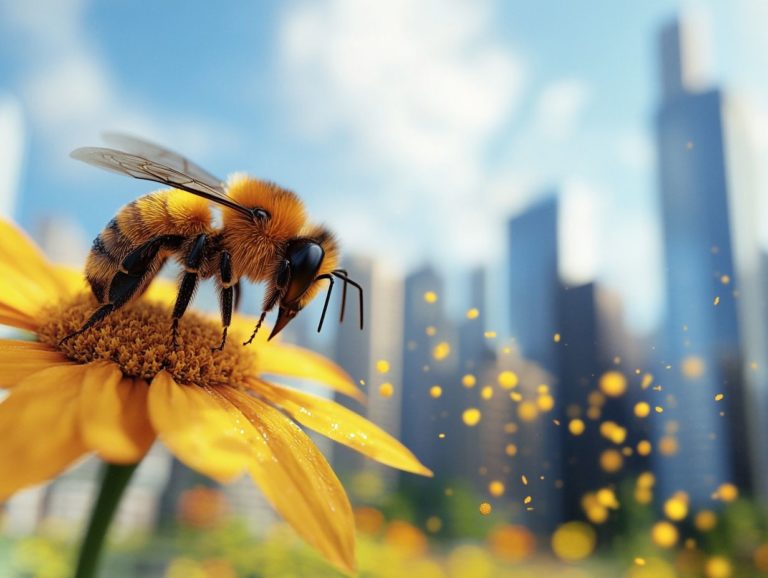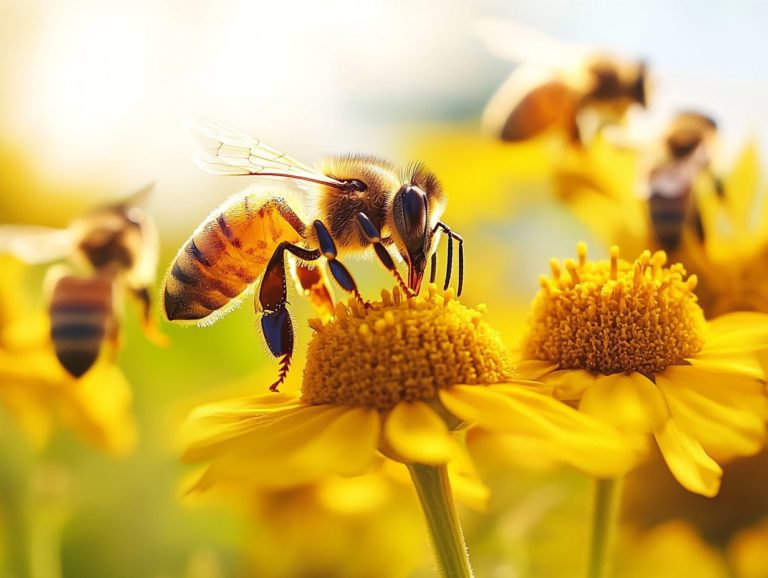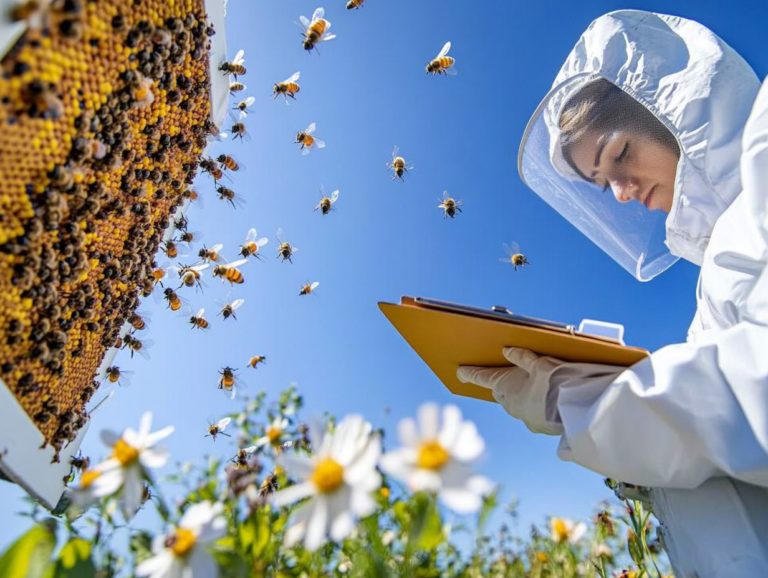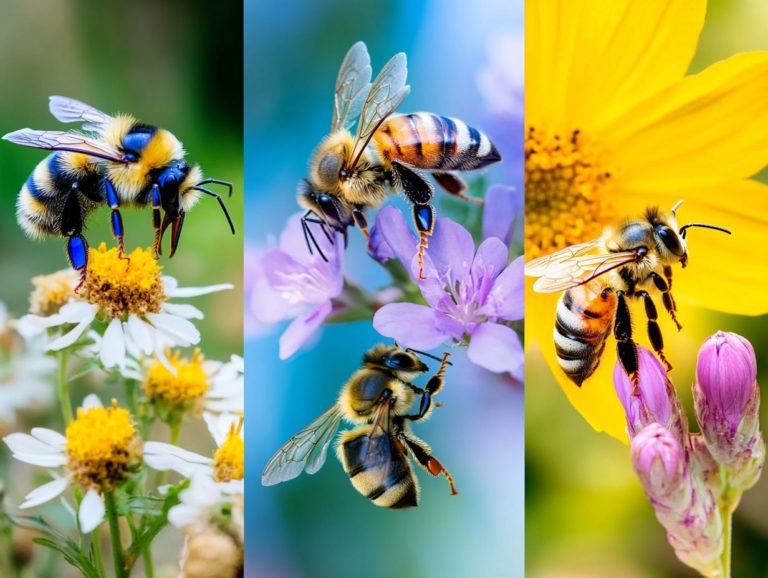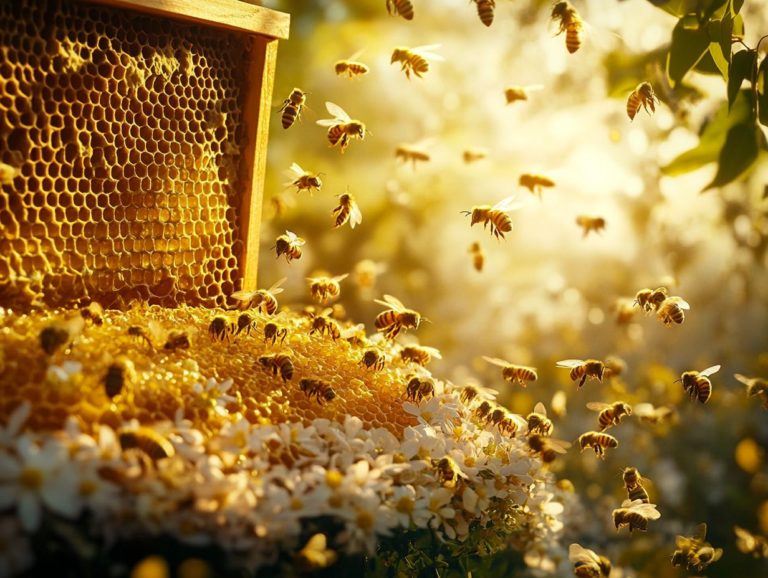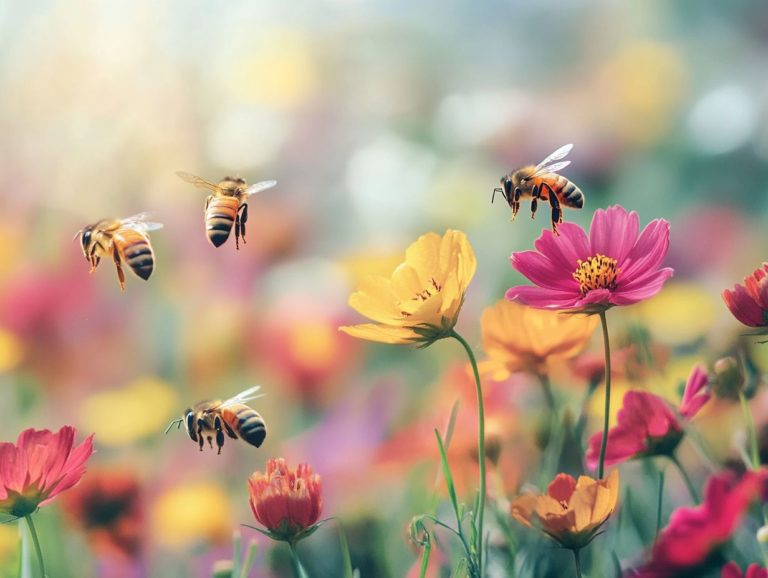Bee Behavior: Understanding Swarming
Swarming is one of the most intriguing behaviors displayed by honey bees, serving as a natural mechanism for colony reproduction and survival.
This exploration takes you deep into the nuances of the swarming process. It sheds light on the reasons behind this phenomenon and the essential communication methods bees employ.
You will discover what triggers swarming, how bees select their new homes, and the potential hazards tied to this behavior.
We will delve into the advantages of swarming, including its impact on genetic diversity and overall colony health. This remarkable occurrence is a key part of bee biology and offers valuable insights into bee dynamics.
Embark on a journey to uncover the secrets of bee swarming and its critical role in their ecosystem. This highlights the importance of urban beekeeping for a better understanding of these insects.
Contents
- Key Takeaways:
- Discover the Fascinating Process of Bee Swarming!
- How Do Bees Communicate?
- What Triggers Swarming in Bees?
- What Happens During a Swarm?
- How Do Bees Choose a New Home?
- How Can Beekeepers Prevent Swarming?
- What Are the Benefits of Swarming for Bees?
- How Can Swarming Be Harmful to Bees?
- What Can We Learn from Bee Swarming Behavior?
- Frequently Asked Questions
Key Takeaways:
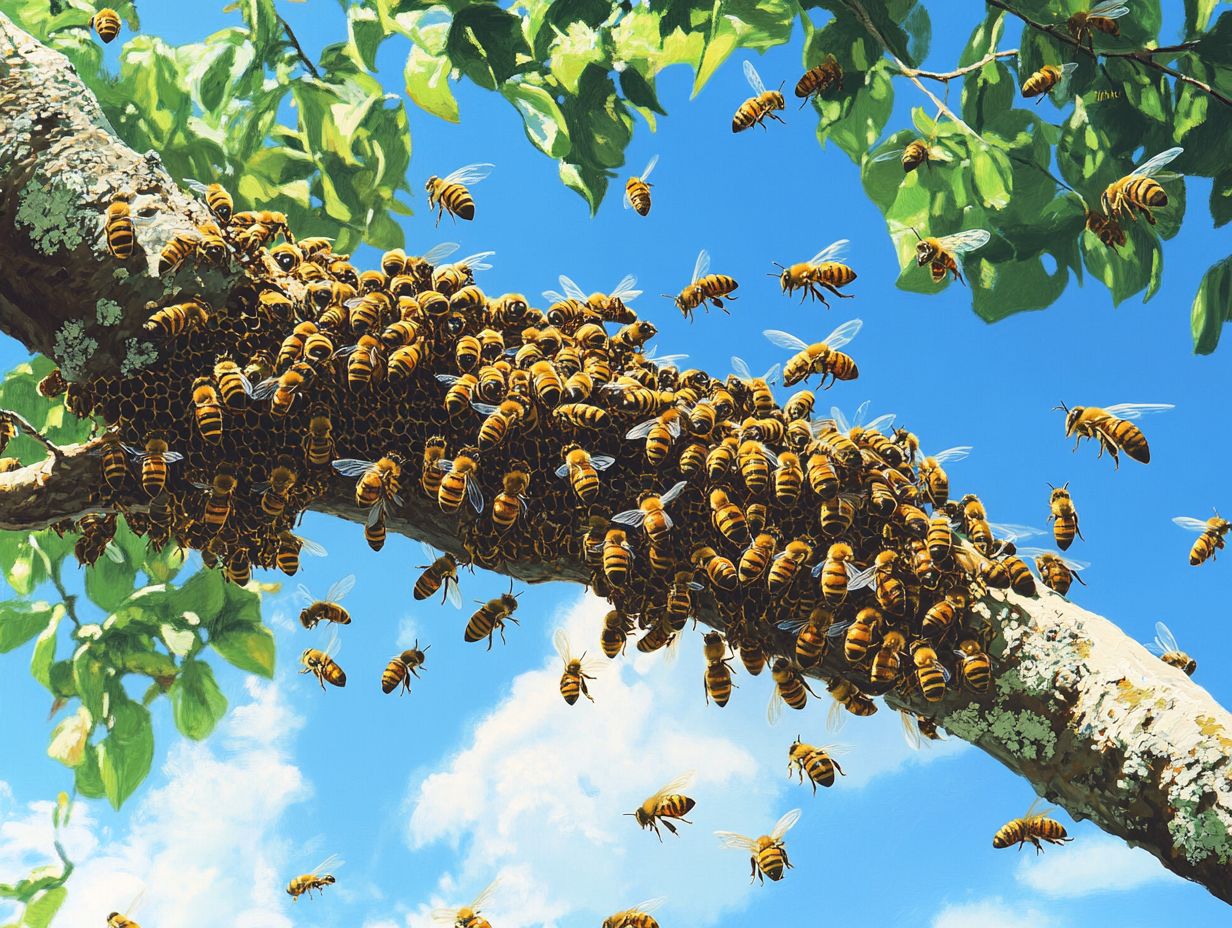
- Understanding bee communication is key to understanding swarming behavior. Different forms of communication, such as chemical signals and dances, play a crucial role in coordinating swarming.
- Swarming is triggered by factors like hive congestion and environmental changes. Beekeepers can prevent swarming by managing these factors and providing suitable new homes.
- Swarming benefits bees by promoting genetic diversity and improving colony survival. However, it can also impact honey production and pose risks. Studying swarming provides insights into bee colony dynamics and behavior.
Discover the Fascinating Process of Bee Swarming!
Swarming is a remarkable natural reproductive process among honey bees. A part of the colony, including the queen bee, departs from the original hive to establish a new colony. This phenomenon typically unfolds during the spring when nectar flow is plentiful, and the hive becomes congested, signaling the perfect moment for expansion.
This spring swarming ensures the colony’s continuation. Worker bees play a vital role, diligently ensuring the survival and continuation of their population. They scout for suitable new homes and expertly manage the hive’s resources, showcasing the intricate teamwork and foraging activity that define these industrious creatures.
How Do Bees Communicate?
Bees possess a remarkable communication system that relies on chemical signals, dances, and vibrations. This allows them to share essential information about foraging activities, potential threats, and the emergence of new colonies. This intricate method of communication is crucial for preserving the social structure within the hive and ensuring that worker bees conduct successful scouting missions.
Chemical signals are particularly significant, especially when it comes to the queen bee’s signaling during the swarming process, highlighting the deep interconnectedness of the colony.
To learn more about the fascinating world of bees and their behaviors, consider exploring urban beekeeping!
What Are the Different Forms of Bee Communication?
Bees employ a fascinating array of communication methods, including pheromones, dances, and vibrations, to share vital information within the colony. These techniques influence their behavior and assist in colony reproduction.
Each method has its own unique purpose. Whether it’s signaling food sources or alerting fellow bees to external threats, these forms of communication ensure the survival and unity of the hive. Such methods are vital for swarm relocation.
Pheromones are pivotal in this intricate communication network. For instance, the queen releases specific chemicals to signal her presence, fostering harmony and coordination among the workers.
When it comes to sharing the location of delicious food sources, the worker bees perform the renowned ‘waggle dance.’ This delightful dance provides crucial spatial information that significantly enhances their foraging efficiency. Such behaviors underscore the importance of bee social structure.
Vibrations add another layer to this communication tapestry. They serve as a subtle yet effective way for bees to convey urgent messages about danger or immediate needs.
Together, these methods create a collaborative environment, enabling bees to adapt swiftly to changing circumstances. This adaptability is essential for the health and productivity of their community.
These communication methods are also integral to the supersedure process, where bees replace an old queen with a new one, as well as other hive dynamics.
What Triggers Swarming in Bees?
Swarming in bees often arises from a blend of environmental stressors and the complex dynamics within the colony itself, such as hive congestion and the necessity for queen replacement.
Effective swarm management can prevent these triggers. As spring unfolds, the growing population and dwindling hive resources amplify the urgency to establish a new colony.
This instinctive response is vital. It not only preserves the genetic diversity of honey bees but also enables them to adapt to the shifting environmental landscape. Understanding these dynamics is crucial for effective colony assessment.
What Are the Factors That Contribute to Swarming?
Several factors play a pivotal role in the fascinating swarming process of bees. These include hive congestion, availability of nectar, and the queen bee’s reproductive capabilities.
When there’s an abundance of pollen resources, it acts as a catalyst for reproductive activities, preparing the colony for the potential of swarming. The presence of swarm cells clearly signals that it s almost time to find a new home, prompting the bees to start migrating. This is a crucial aspect of the bee lifecycle.
Environmental conditions are equally important. When the weather is favorable, marked by warm temperatures and consistent floral resources, it enhances foraging and hive activity. This ultimately leads to significant colony growth.
Such conditions also support successful brood rearing and new nest establishment. As the hive becomes increasingly crowded with bees and honey, the need for relocation becomes pressing.
On bright sunny days with optimal flight conditions, the bees are more likely to venture out and establish a new colony. These various elements intertwine seamlessly, reinforcing the survival strategy of swarming. This strategy is essential for the ongoing proliferation and health of bee populations.
What Happens During a Swarm?
During a swarm, a remarkable transformation takes place. A substantial number of worker bees and the queen gracefully depart from the original hive to establish a new colony.
This fascinating process commences with the emergence of a new queen. She embarks on mating flights to promote genetic diversity before selecting an ideal location to settle. Such bee migration ensures the health and productivity of the colony.
The worker bees play a pivotal role in this journey. They diligently scout for new nesting sites, which is essential during this relocation phase. Their efforts lay the groundwork for the colony’s future success and thriving foraging activities.
This relocalization is a key part of their survival strategy.
What Are the Stages of Swarming?
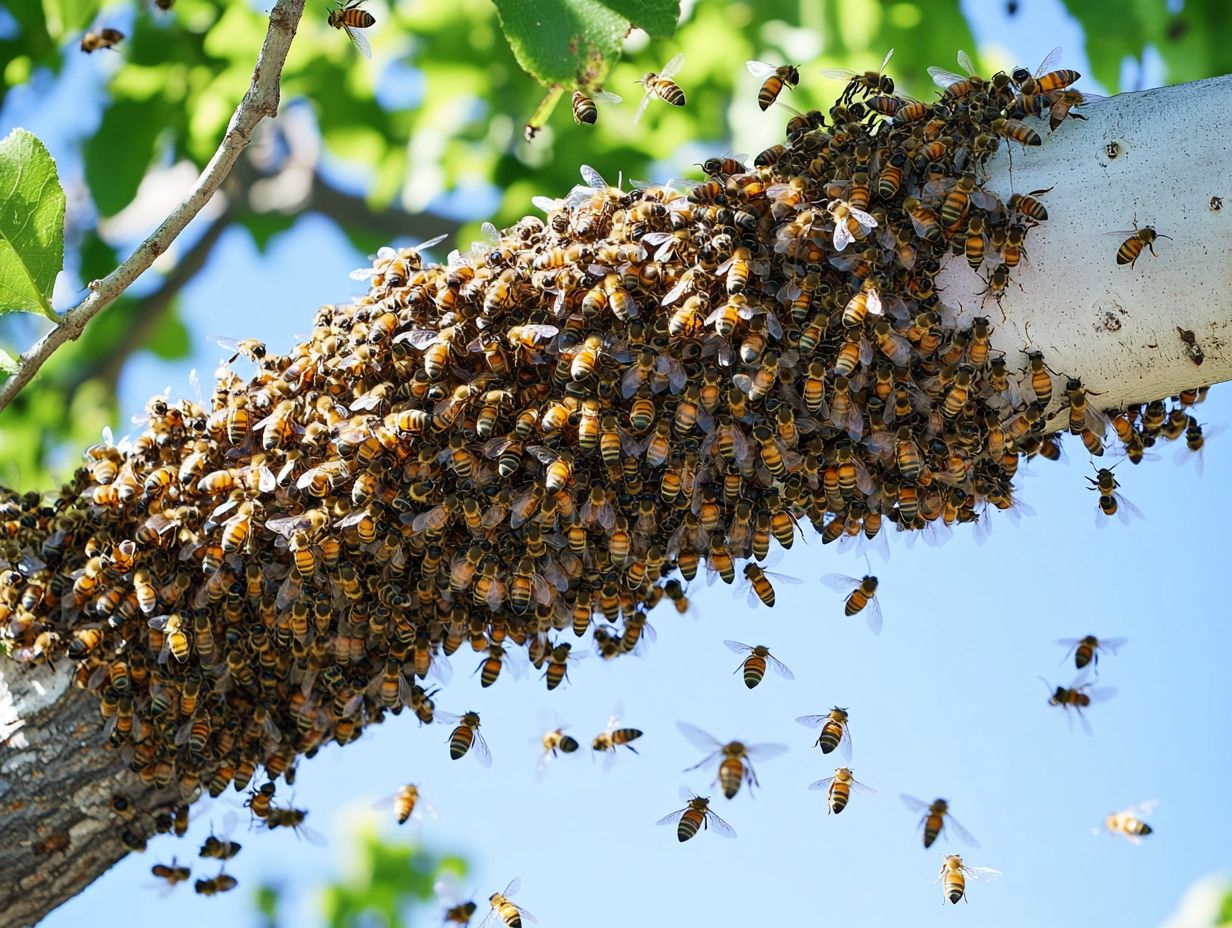
The swarming process unfolds in several key stages that you should be aware of, starting with the development of swarm cells within the hive. Swarm cells are special cells where new queen bees develop. This is followed by the emergence of a new queen bee and culminates in the establishment of a new nest. Each stage is intricately influenced by environmental stressors that impact the dynamics of the colony. This prompts the worker bees to prepare for their eventual departure from the original hive. This process ensures the ongoing survival and health of the bee population.
Initially, the workers spring into action, constructing specialized cells known as swarm cells, where potential new queens will develop. These cells are crucial for ensuring the colony’s survival, serving as a clear signal of impending change. This showcases their skill in building comb!
Once those swarm cells reach maturity, the old queen takes her leave. This paves the way for the new queen to emerge and assert her dominance. This emergence signifies a pivotal transition in the colony’s lifecycle. The workers enthusiastically rally to support their new leader. This queen emergence is a critical part of the bee lifecycle.
As external conditions evolve whether due to shifts in temperature or changes in resource availability the bee colony embarks on a collective search for a suitable new nesting site where they can thrive once again. Such adaptability underscores the importance of understanding bee biology.
How Do Bees Choose a New Home?
When selecting a new home, bees display intriguing behaviors that illustrate their clever way of making decisions together. Their colony assessment takes into account various factors critical for survival.
They depend on scouting bees to assess potential nesting sites. These scouts meticulously evaluate various criteria. They consider factors such as resources in the hive, environmental conditions, and proximity to abundant pollen and nectar sources. This careful assessment ensures that the new colony is positioned for success and sustainability right from the start!
What Are the Criteria for a Suitable New Home?
When bees search for a new home, they carefully consider a range of criteria, putting a premium on environmental conditions, available resources in the hive, and food sources that support their honey production. Key factors such as temperature control, protection from external threats, and proximity to rich pollen and nectar sources are essential for the survival and health of the new colony. This involves meticulous colony assessment to ensure sustainability.
The architectural features of a potential hive, including its size and depth, significantly influence how bees evaluate the viability of their habitat. A spacious environment is crucial, providing optimal honey storage and ample room for growth as the population expands. Effective hive ventilation also plays a key role in maintaining hive health.
Adequate ventilation is vital as it helps regulate humidity levels and prevents fungal infections that could threaten the bees well-being. When a colony can establish itself near abundant flowering plants, it secures a steady food supply. This is essential not only for the survival of its members but also for maximizing honey production, ultimately ensuring the colony’s prosperity. Such planning is integral to bee migration and colony survival.
How Can Beekeepers Prevent Swarming?
You can effectively prevent swarming in your beehives by employing a range of strategic hive management techniques. Regularly assess your colonies, replace queens in a timely manner, and address any environmental stressors that could contribute to hive congestion. This includes monitoring swarm cells and ensuring adequate nectar and pollen resources within the hive.
By implementing these practices, you ll not only maintain a healthy colony but also sustain honey production. All while minimizing the risk of losing valuable worker bees to the swarm process! Start implementing these strategies today to keep your bees buzzing happily!
What Are the Methods for Swarm Prevention?
Effective swarm prevention methods involve managing hive congestion by providing adequate space, implementing queen replacement strategies, and promoting optimal brood rearing practices. By maintaining a balanced colony environment, you can significantly reduce the likelihood of swarming and support the overall health of honey bee populations. Additionally, understanding bee behavior and bee lifecycle stages can help you plan more effective swarm prevention measures.
It s essential for you to understand the intricate dynamics within the hive; when space is well-managed, worker bees can perform their essential functions more effectively. Ensuring there is ample room for brood, food stores, and ventilation can dramatically enhance the stability of your colony.
Regularly monitoring the queen s performance and replacing her when necessary is crucial to maintaining a healthy brood pattern, which is vital for sustaining your worker bee populations. By prioritizing these strategies, including comb building and ensuring temperature control, you can create a nurturing environment that minimizes the urge to swarm and promotes a thriving apiary.
What Are the Benefits of Swarming for Bees?
Swarming offers several essential advantages for bees, primarily by promoting genetic diversity and bolstering colony survival. This process is a crucial aspect of colony reproduction and helps bees establish new colonies in diverse environments.
When bees disperse and establish new colonies, they are able to adapt to various environmental conditions, which significantly strengthens the resilience of the bee ecosystem. This adaptation includes finding new nests that offer suitable hive resources and temperature control.
Additionally, effective swarming boosts honey production and plays a vital role in maintaining a sustainable bee population. The reproductive process during swarming ensures that bees can thrive in various environments, from rural areas to urban beekeeping settings.
How Does Swarming Help with Genetic Diversity?
Swarming plays a significant role in enhancing the genetic diversity within honey bee populations, allowing for the creation of new colonies that embody a variety of genetic traits. During the reproductive process of swarming, the queen bee takes to the skies for a mating flight, where she mates with multiple drones. This practice ensures a diverse gene pool, which can bolster resilience against diseases and environmental changes.
This unique mating strategy is pivotal, as it not only amplifies the genetic variability among the offspring but also strengthens the colony’s survival capabilities. By selecting drones from different colonies, the queen bee introduces a tapestry of genetic traits that heightens the hive’s ability to adapt to shifting environmental conditions and potential threats.
Such genetic robustness is essential for maintaining healthy populations, fostering greater resistance to pests, pathogens, and climate variations. In this manner, swarming serves as a crucial mechanism that underpins the long-term viability and success of honey bee populations within their ecosystems.
What Are the Advantages of Swarming for Colony Survival?
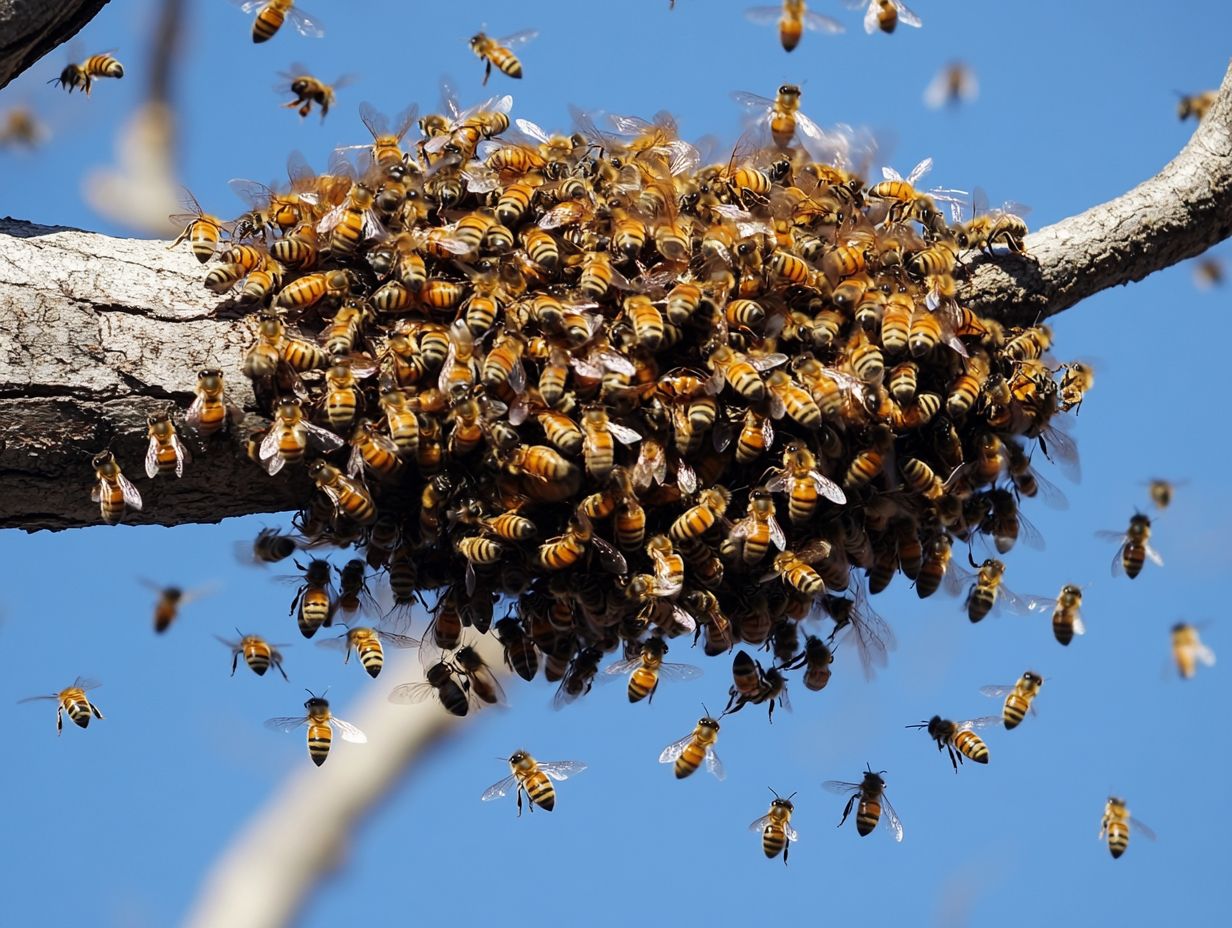
The advantages of swarming for your colony s survival are quite remarkable. It redistributes bee populations, effectively mitigating risks from external threats and environmental stressors. This behavior is essential for maintaining colony stability and ensuring long-term survival.
By establishing new colonies, swarming significantly enhances the chances of survival for individual bees and ensures that honey bee populations continue to thrive in a variety of habitats.
Beyond mere population management, swarming initiates a reproductive cycle that fosters genetic diversity, which is crucial for resilience against diseases and pests. As your colony splits and relocates, it not only alleviates overcrowding but also opens doors to adapting to new environments, potentially offering better foraging resources or more favorable weather conditions.
This instinctual behavior is vital for securing the future of the colony. It equips them to thrive even in the face of rapid changes in their surroundings, ultimately supporting long-term survival and maintaining ecological balance.
How Can Swarming Be Harmful to Bees?
While swarming is a natural process, it carries significant risks for bee populations that can affect colony stability and honey production. The stresses linked to swarming may render the hive vulnerable to external threats, potentially compromising the health of the remaining bees.
Gaining a clear understanding of these harmful effects is crucial for implementing effective swarm management strategies. This knowledge is particularly vital in urban beekeeping, especially when learning how bees know when to swarm, as swarming can pose unique challenges.
What Are the Risks of Swarming for Bees?
The risks associated with swarming for bees are significant. When a considerable portion of the colony takes flight, the hive becomes more vulnerable to environmental stressors and potential predators.
This exodus disrupts honey production, as the remaining bees need to allocate resources with a diminished workforce. This complicates brood rearing the process of caring for young bees and hive ventilation.
With fewer bees on the job, their foraging efforts are hampered, ultimately impacting the overall health of the hive. A smaller bee population means a reduced ability to defend against intruders or diseases, leaving the hive more exposed to external threats.
Additionally, structural changes within the hive can alter the social dynamics among the remaining worker bees, leading to further confusion and disarray.
Such upheaval can prolong recovery times and hinder future honey production, putting the colony’s long-term survival at risk. These challenges highlight the critical connection between swarming, colony integrity, and the vital ecological contributions bees make.
Learning about bee biology and insect behavior can further inform effective swarm management practices.
How Does Swarming Affect Honey Production?
Swarming can significantly hinder honey production by diminishing the number of worker bees available to collect vital nectar and pollen. This reduction in colony health can translate into lower honey yields, particularly if the swarm occurs during critical nectar flow periods.
Imagine a scenario where a substantial portion of the bee population departs to establish a new colony; the foraging capability of the remaining bees takes a hit, making it challenging for them to take full advantage of peak blooming seasons.
Environmental factors like temperature fluctuations and varied rainfall can also amplify these challenges. If the remaining bees aren t well-equipped to adapt to these shifts, their efficiency in nectar collection will likely suffer.
The lifecycle stages of bees also play a pivotal role in this equation. Younger foragers generally contribute more significantly to honey production. When swarming happens, there s often a delay in the maturation of new bees, complicating the already delicate dynamics of honey yields during essential harvest periods.
Additionally, absconding behavior when bees leave the hive abruptly and the supersedure process can further impact the colony’s productivity.
What Can We Learn from Bee Swarming Behavior?
Understanding bee swarming behavior is essential for effective beekeeping and environmental health. It offers invaluable insights into the intricate dynamics of colony life, the decision-making processes at play, and the wider implications for environmental adaptation among bee populations.
By observing how these remarkable creatures communicate and choose new habitats, you gain a deeper understanding of the complexities inherent in their social structure and the myriad challenges they encounter in ever-changing environments.
The role of scouting bees and pheromone control is particularly fascinating in this context. Act quickly to manage swarming to protect your bees and ensure a thriving colony!
How Does Swarming Help Us Understand Bee Colony Dynamics?
Swarming provides you with a fascinating glimpse into the dynamics of bee colonies, illustrating how these remarkable creatures interact and make collective decisions based on their environment. This behavior underscores the importance of communication and social structure, delivering essential insights into how bee populations adapt and thrive in the face of challenges. Understanding the queen emergence during swarming is crucial for grasping these dynamics.
By observing the intricate signals and cues within the swarm, you can uncover the mechanisms that guide these insects in their movements and choices. For example, the pheromones released by scout bees are crucial in informing the colony about promising nesting sites, while the collective dynamics during swarming highlight the significance of shared information in reaching consensus.
This collective decision-making process not only enhances survival strategies but also serves as a powerful example of how social beings can effectively navigate external pressures. As bees maneuver through changing environments, their strategies impart valuable lessons about resilience and cooperation that resonate well beyond the hive. This knowledge is also relevant for urban beekeeping practices.
What Does Swarming Tell Us About Bee Communication and Decision Making?
Swarming offers you a captivating glimpse into the world of bee communication and their decision-making processes. Imagine scouting bees expertly relaying vital information to the colony about potential new homes. This intricate dance of information highlights the significance of effective communication and collective decision-making when it comes to ensuring the survival of the colony.
As you observe these remarkable honey bees, you’ll notice their impressive social dynamics at play. They deftly navigate challenges by relying on pheromonal signals and intricate dances to convey critical messages. Through these coordinated efforts, they assess various environmental factors, such as food availability, nesting site qualities, and climatic conditions, hive resources, and pollen resources each crucial for their collective well-being.
By diving into these fascinating behaviors, you not only gain insight into bee ecology but also recognize the broader implications for their resilience and the overall health of our ecosystems, especially in the face of habitat loss and climate change. The interplay between individual actions and the collective needs of the colony reveals nature’s complexity and underscores the vital roles these pollinators play in sustaining biodiversity, bee population, and honey production.
Frequently Asked Questions
What is swarming in bee behavior?
Swarming is a natural process in the life cycle of honeybees where a new queen bee and a large group of worker bees leave the parent hive to form a new colony. This swarm process ensures the reproductive success and survival of the colony.
Why do bees swarm?
Bees swarm for two main reasons: first, when hive congestion occurs and there is not enough space for the colony to expand, and second, when a new queen is produced and the old queen leaves with a large group of worker bees to start a new colony. This is a vital part of the colony reproduction process.
How do bees decide when to swarm?
Bees have a unique way of communicating through a series of dances and pheromones to indicate when the colony is ready to swarm. The queen bee also plays a crucial role in the decision-making process, along with scouting bees that assess new nest sites.
What happens during a bee swarm?
During a swarm, the queen bee and a large group of worker bees leave the original hive and form a dense cluster on a nearby object, such as a tree branch or fence. The bees will protect and care for the queen while scout bees search for a suitable location to build a new hive, thus initiating the new colony formation.
Is a bee swarm dangerous?
A bee swarm is generally not dangerous, as the bees are focused on finding a new home and do not have a hive to defend. However, it is important to keep a safe distance and seek professional help if the swarm is located in a high-traffic area. In cases of dangerous swarms, swarm relocation by professionals is necessary.
What should I do if I encounter a bee swarm?
If you encounter a bee swarm, stay calm and avoid disturbing the bees. Keep a safe distance.
Contact a local beekeeper or pest control professional for help. They can safely remove the swarm. Taking quick action is key! Help is just a call away, so be proactive and protect both yourself and the bees.

